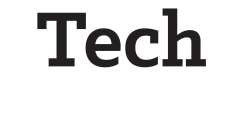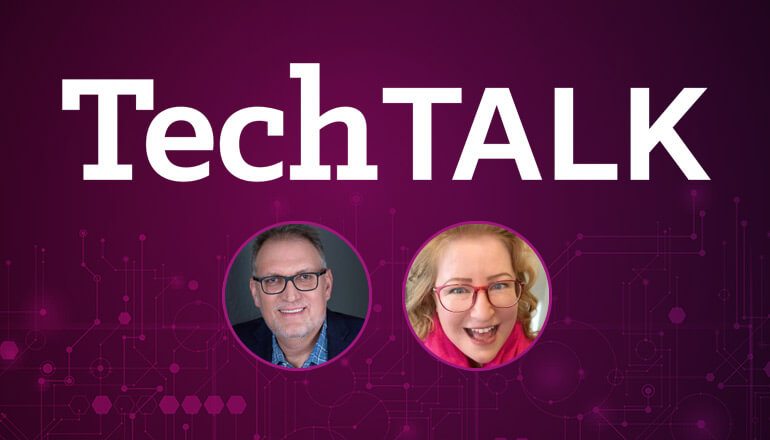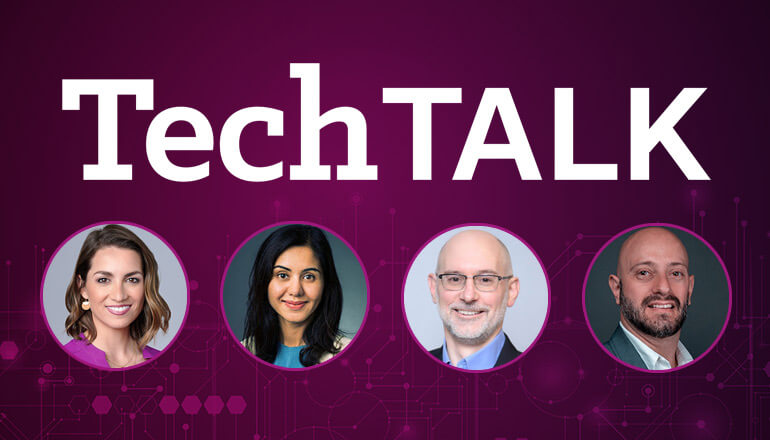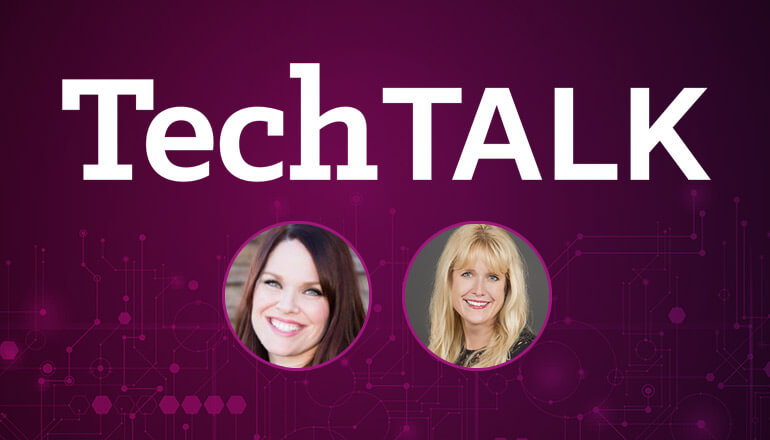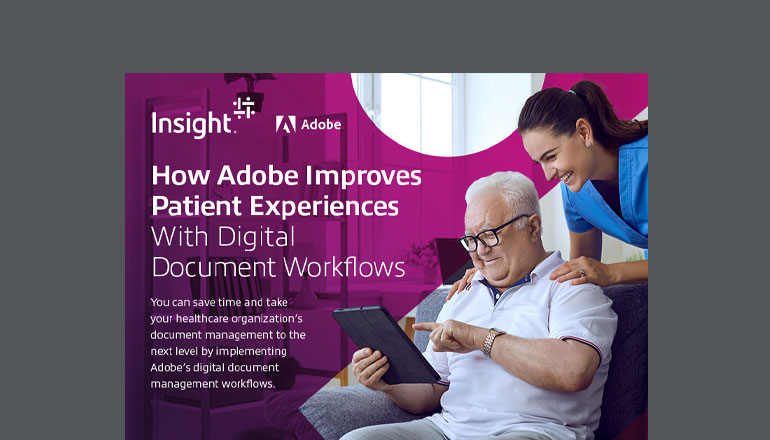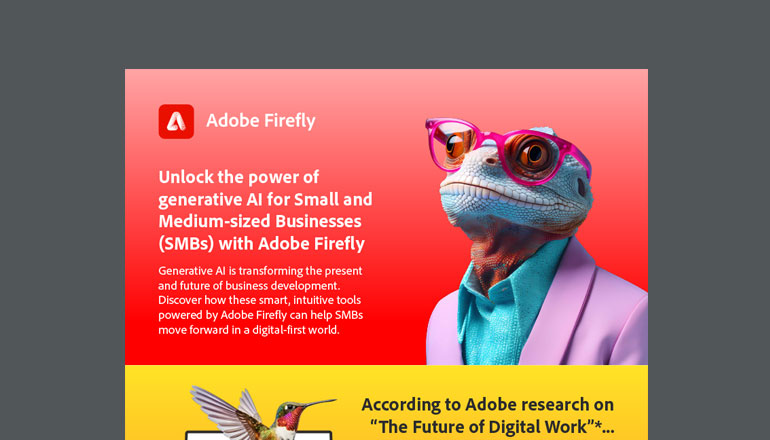Audio transcript:
The Future of Design: How Generative AI Is Empowering Creatives
Jillian
Hello, and thank you for joining us for an Insight TechTalk. I'm your host, Jillian Viner. Generative AI has been a hot topic among knowledge workers, but there's a subset of people that have very strong opinions about what this technology means for their own work. Today, to have the conversation about the impacts of generative AI among the creative class, we thought no one better to talk to than someone from Adobe. I'm very pleased to welcome back to our Insight TechTalk Lori DeFurio, our principal evangelist of Adobe. Lori, welcome.
Lori
Thank you, Jillian. It's so good to be back and be able to talk to you and chat with your users and your customers.
Jillian
Let's just cut right to the chase, Lori, because as I said, there's some strong opinions about what generative AI means for workers. It's sort of been a blessing for knowledge workers trying to comb through meetings and emails and large documents, but there are a lot of strong feelings about what it means among creatives. So what are you hearing over at Adobe?
Lori
Yeah, that's a great question. And I think early on when this, you know, a year ago we introduced Firefly, which is our generative AI technology for the creatives, people were very concerned. There was a little bit of fear, a little bit of FUD, a little bit of everything. And I think that, you know, a year into this now, what we've really seen is that this is progressing at a very advanced pace. And not only is it affecting the creatives themselves, the people that are, you know, behind the scenes making all this beautiful artwork that we see every day, but also for business leaders. They're going to invest in what technology and how to invest in their creatives as, you know, human capital. So that's really important. And the thing is, they want to, you know, think about things like, "Where do we add value? And, you know, is AI responsible?" and things like that across the band. Across the brand. Excuse me. Yeah.
Jillian
Makes sense. Firefly is, by the way, very fun. I've played with it quite a bit myself. You never really know what you're going to get. So when you're talking about this technology is evolving very quickly, how is Adobe kind of keeping a pulse on, you know, that fear or interest among the community? And how do you respond to it?
Lori
Yeah, absolutely. So we're constantly engaging with the community. We either go to live events or virtual conferences, workshops. We do focus groups all the time, all around the world, globally. We want to make sure we're getting global feedback and diverse feedback, right? So I'm going to read some stats, if you don't mind. So in our most recent survey, we surveyed 2,500 creatives from the US, the UK, Germany, France, Japan, Korea, Australia, New Zealand, all right, there's my laundry list, about how they're using it and, you know, what are they doing. So here's some really interesting stats. Now, 83% of these folks said that they're using generative AI in their work today, and 74% of them are using it in their personal lives as well. So that was kind of an interesting tidbit, that it's not just about work, but it's about a, you know, personal and professional blended environment that you're in. They're open to the technology. You know, I think early on there was a lot of, you know, nervousness about what about my job, and what about my life? But the thing is, 66% are saying that they're making better content now, which, of course, is one of our goals at Adobe, right? That these talented creatives are always looking for new ways to do cool things. And one of the great things that Firefly brings to the table is ideation. You're not starting with a blank sheet of paper. You can-
Jillian
That is the hardest part.
Lori
try something. A tropical island paradise with pristine turquoise waters and lush greenery. I mean, you know, on and on, to just get some, oh, that's what I was thinking about. That's what was interesting. And then you can build on it, you know, to go from there. So I think it's helping with creative inspiration, as well as helping with reducing the tedium. And we have so much content velocity right now. I mean, think of all the social media platforms you have. And I need to have my graphics out there, or I'm doing a global campaign, and I have all these different sizes and localization and regional changes. How do I do that all? Generative AI helps there, 'cause it can expand an image, it can automatically generate seven flavors of it, and things like that, to really help us get there.
Jillian
That, to me, feels like music to my ears because that's not the creative work, that's the tedious work.
Lori
Yeah, it is.
Jillian
Or, like, even the expensive work, because of the hours that it takes to do the translations for localization, or to resize something to fit all those different formats. So you're telling me that this technology can now do all that for me?
Lori
Absolutely. 62% of these creatives that we interviewed said that they're reducing the time on a task about up to 20%. So okay, great. So I've saved a lot of time, right? What am I going to do with that time? Okay, what am I going to do with that time? Well, if I'm a creative, it allows me to be more creative and come up with new things. But if we look at it from the business side, we can get to market faster. We can start new campaigns. We can do all sorts of different diverse things that we might not have been able to do while people were doing their other things. And it also becomes a competitive advantage and/or cost savings.
Jillian
Sure. Actually, I like it because it allows you that free time to really think critically about what you're doing, right? It's not always a matter of get things done so that we can do more, but so that we can do the right work and do it with intention, right? Get rid of the tedium and focus on thinking through what it is that we're trying to accomplish.
Lori
Yeah. You mentioned knowledge workers at the beginning. You can relate it back to that as well, right? Okay, I'm a knowledge worker, and generative AI is helping me do this task more quickly, because, you know, generative AI is helping me. What do I do with my extra time? And I think that's true across any role. If you're, you know, an individual contributor, what can I do with that role? How can I, you know, do something better, to do something else with my time? Do you know what I mean?
Jillian
I do. In fact, I'll take it back to your example of the blank page. I'm a writer myself, and getting through that blank page is often the hardest part. Getting into that sort of flow state. And that's where, like, the real magic happens. So if I have a tool that's going to help me get from the white screen, blank page, oh my gosh, this is terrifying, into, okay, now I'm a paragraph in, now I'm two paragraphs in, and now I'm really flowing, that's where the meaningful work comes in. So I don't mind that little shortcut at the end if it's going to help me get to where the neat stuff is. You know what I mean?
Lori
Yeah. And it's exactly the same for the creatives, right? They need to sometimes just get a jumpstart. Or where can I take this to the next level? I have an image that I'm starting with. Now I want to build on it. Or a campaign. So that's kind of cool.
Jillian
So Lori, I want to ask you about another fear that creatives have, which is sort of the ownership and the responsible AI side of it. What is Adobe doing to make sure that, first of all, the creative set that we're producing is protected, and that you're not stealing what's out there already?
Lori
This is an uncharted territory for a lot of people. So I think from a business point of view, they need to think about creating a business strategy for the organization on how they use gen AI and an internal ethics committee, if you don't already have one. And how to research apps and services. Just make sure that the organization you're looking at and the technology you're looking at has its own strategy. Do they have an ethics committee? Do they publish how they train their models, and so on? Do they have accountability, responsibility, and transparency? And do they provide security and privacy? So that's kind of the business side of it, but let's take it back to the creative. So from a creative point of view, one of the things that Adobe did was we created the Content Authenticity Initiative, CAI for short, I'll say that a couple of times, in partnership with the New York Times in 2019. And today there's over 2,500 organizations as members.
Now, what is this all about? This is where we're all getting together, making sure that we can prove the source of content. Was this created organically, or was it organic plus some generative AI added on? And this is not just photos, it's photos and videos. So as a creative, you can be confident that your content is being protected. And we trained our LLM, that's the large learning model, that's the underlying things for generative AI, on Adobe Stock, which is all royalty-free content that Adobe licensed from creative professionals. So everything that we are using is, you know, commercially safe to use and that. Now, one other thing to think about is for brands. You know, I might be a beverage brand, and I want to train on my stuff, my bottles, my cans, my whatever. What's interesting is we have this ability to add onto the LLM that was done for everybody, and that's private. Only anybody in your organization can see those models. But it allows you to take that huge database of LLM and add on with your specific brand. It's pretty exciting. I love this. Now, back to the CAI for a second.
Jillian
Sure.
Lori
In it is something called content credentials. And this is like a digital nutrition label, if you think about food. What's in it? It'll show me. And you just click on it, and it pops it up in Photoshop or in YouTube, all these different places. I can see how it was created, who created it. Even you can see what camera created it, things like that. All of that metadata is stored with it to really help, not just the creatives feel that their stuff's been protected, but for an end user or a consumer to know where it came from, and is it real, or is it fake?
Jillian
That's so smart. I feel like that's such a big problem or big challenge that people have been struggling with ever since generative AI became mainstream, right, is we don't know what's real, what's been generated. So it's nice that you're creating almost like a paper trail, if you will, even though everything's digital. We kind of see where that's coming from. I wanted to go back to your creative solution about the large language model. Let's say we want to use it here at Insight and give it our branding stuff. Does that mean that we can create stock images that really look and feel like our brand, because we're able to infuse that with our brand guidelines?
Lori
Yes. So the way it works, if you don't mind, I'll get a little technical with your audience. You upload some of your images of your, whether it's the design, it's the style, it's the object, you know, it's that inside look and feel, and it trains, Firefly will train on that. So when you are in firefly.adobe.com or Photoshop or Illustrator or Premier Pro, wherever you happen to be, and you want to do some generative AI, whether it's text to image, building something from scratch, or using what we call generative fill or generative expand to make something fit better what you need to do, you can apply your model on top of it. So you can say things like, "Here's the picture, but I want it to have the style of my model." And it'll bring that right in so that it will really feel like it came. And it's not detracting from a creative who maybe spent a lot of time trying to design your materials. It just augments it in an easy way that helps you understand that your brand is being represented. And as I mentioned-
Jillian
Got it.
Lori
inside your firewall, it's only for your organization and no one else. We don't train on it, either. I mean, we train there, but we don't train the rest of the world on it, and we don't share it with anybody else.
Jillian
So it's secure, just for our business.
Lori
Absolutely. Yeah.
Jillian
That sounds great. I love that you used the word augment. I like that we continue to think of these generative AI tools as augmenting human capabilities, amplifying creativity. It's really what it's all about. I feel like the solutions and features that you've told us about today are really all the things that creatives have maybe been wanting for years. Just things that make the process easier, faster, and help you sort of bring those brilliant concepts to life. So I don't know, you kind of made a believer of me, not that I need much convincing. I admitted I like Firefly. I've used it quite a bit. But it sounds like great stuff.
Lori
Absolutely. And I encourage everyone that's watching or listening, just go to firefly.adobe.com. It's freely available to test it and try it and experiment. And every time we introduce a new tool, it'll be there first, in a beta format or in a tech preview format for you to experiment with it, before you might see it into one of our tools like Photoshop or things like that.
Jillian
That's a great tip. That's a great tip. And for our listeners, if you'd like any more information about Adobe, you can just go to insight.com/adobe. We've got it all there. Thank you so much for joining us today, Lori. Love the conversation. I love the creative side and how generative AI is truly impacting everybody and every industry. Thank you for your insights.
Lori
Well, thanks for having me, Jillian. And I'm happy to continue the conversation in the future.
Jillian
Sounds great. We'll have to have you back. And for our listeners, once again, you can visit insight.com/adobe for more information. We'll see you next time on Insight TechTalk. Bye now.
